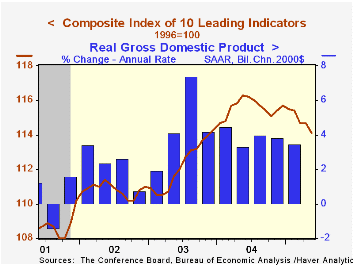 Global| Jun 20 2005
Global| Jun 20 2005Leading Indicators Down Again
by:Tom Moeller
|in:Economy in Brief
Summary
The Composite Index of Leading Economic Indicators reported by the Conference Board fell a sharp 0.5% in May following an upwardly revised no change in April. Six-month growth in the leaders dropped to -2.2%. Growth in the leaders [...]

The Composite Index of Leading Economic Indicators reported by the Conference Board fell a sharp 0.5% in May following an upwardly revised no change in April. Six-month growth in the leaders dropped to -2.2%. Growth in the leaders deeper than -2.5% preceded past US recessions.
During the last ten years there has been a 50% correlation between the six-month change in the leading indicators and the change in real GDP.
Amongst the 10 components of the leading index, the breadth of one month gain retraced the prior month's improvement and fell to just 15%. In May, a flatter interest rate yield curve, lower building permits, and higher claims for unemployment insurance made the largest negative contributions. During the last year the leading indicators have fallen 1.9%, roughly half of which was due to the flatter yield curve and the rest was due to the drop in vendor performance.
The leading index is based on eight previously reported economic data series. Two series, orders for consumer goods and orders for capital goods, are estimated.
The coincident indicators rose by 0.2% (2.1% y/y) for the third month in the last four.
The lagging indicators rose 0.3% in May though the prior month's gain was revised down to 0.1%.
The ratio of the coincident to the lagging indicators which measures actual economic performance relative to excess dipped slightly and has been roughly unchanged since last October except for an upward blip in December.
Visit the Conference Board's site for coverage of leading indicator series from around the world.
| Business Cycle Indicators | May | April | 6-Month Chg | 2004 | 2003 | 2002 |
|---|---|---|---|---|---|---|
| Leading | -0.5% | 0.0% | -1.0% | 2.9% | 1.3% | 2.1% |
| Coincident | 0.2% | 0.2% | 3.1% | 2.6% | 0.4% | -0.6% |
| Lagging | 0.3% | 0.1% | 1.0% | -2.1% | -1.9% | -2.3% |
Tom Moeller
AuthorMore in Author Profile »Prior to joining Haver Analytics in 2000, Mr. Moeller worked as the Economist at Chancellor Capital Management from 1985 to 1999. There, he developed comprehensive economic forecasts and interpreted economic data for equity and fixed income portfolio managers. Also at Chancellor, Mr. Moeller worked as an equity analyst and was responsible for researching and rating companies in the economically sensitive automobile and housing industries for investment in Chancellor’s equity portfolio. Prior to joining Chancellor, Mr. Moeller was an Economist at Citibank from 1979 to 1984. He also analyzed pricing behavior in the metals industry for the Council on Wage and Price Stability in Washington, D.C. In 1999, Mr. Moeller received the award for most accurate forecast from the Forecasters' Club of New York. From 1990 to 1992 he was President of the New York Association for Business Economists. Mr. Moeller earned an M.B.A. in Finance from Fordham University, where he graduated in 1987. He holds a Bachelor of Arts in Economics from George Washington University.






